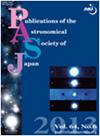Giant molecular clouds and their type classification in M 74: Toward understanding star formation and cloud evolution
IF 2.6
4区 物理与天体物理
Q2 ASTRONOMY & ASTROPHYSICS
引用次数: 0
Abstract
We investigated the giant molecular clouds (GMCs) in M 74 (NGC 628), using data obtained from the PHANGS (Physics at High Angular resolution in Nearby GalaxieS) project. We applied GMC types according to the activity of star formation: Type I without star formation, Type II with H$\alpha$ luminosity ($L_{\mathrm{H\alpha }}$) less than $10^{37.5}\ \rm{erg\ s ^{-1}}$, and Type III with $L_{\mathrm{H\alpha }}$ greater than $10^{37.5}\ \rm{erg\ s^{-1}}$. A total of 432 GMCs were identified, with 59, 201, and 172 GMCs, for Types I, II, and III, respectively. The size and mass of the GMCs range from 23 to 238 pc and $10^{4.9}$ to $10^{7.1}\, M_{\odot }$, indicating that the mass and radius increase from Types I to III. Clusters younger than 4 Myr and H ii regions are concentrated within 150 pc of a GMC, indicating a tight association between these young objects and GMCs. The virial ratio decreases from Type I to Type III, indicating that Type III GMCs are the most gravitationally relaxed among the three. We interpret that the GMCs evolve from Type I to Type III, as previously observed in the Large Magellanic Cloud. Based on a steady-state assumption, the estimated evolutionary timescales of Types I, II, and III are 1, 5, and 4 Myr, respectively. We assume that the timescale of Type III is equal to the age of the associated clusters, indicating a GMC lifetime of 10 Myr or longer. Although Chevance et al. (2020, MNRAS, 493, 2872) investigated GMCs using the same PHANGS dataset of M 74, they did not define a GMC, reaching an evolutionary picture with a 20 Myr duration of the non-star-forming phase, which is five times longer than 4 Myr. We compare the present results with those of Chevance et al. (2020, MNRAS, 493, 2872) and argue that defining individual GMCs is essential for understanding GMC evolution.M 74中的巨型分子云及其类型划分:了解恒星形成和云演化
我们利用 PHANGS(Physics at High Angular Resolution in Nearby GalaxieS)项目获得的数据研究了 M 74(NGC 628)中的巨分子云(GMC)。我们根据恒星形成的活跃程度划分了 GMC 类型:I型没有恒星形成,II型的H$\alpha$光度($L_{\mathrm{H\alpha }}$)小于$10^{37.5}\rm{erg\s ^{-1}}$,III型的$L_{\mathrm{H\alpha }}$大于$10^{37.5}\rm{erg\s ^{-1}}$。总共发现了 432 个 GMC,其中 I 型、II 型和 III 型分别有 59 个、201 个和 172 个 GMC。GMC的大小和质量范围分别为23到238 pc和10^{4.9}$到10^{7.1}/, M_{\odot }$,表明从I型到III型,质量和半径都在增加。小于 4 Myr 的星团和 H ii 区域都集中在一个 GMC 的 150 pc 范围内,这表明这些年轻天体和 GMC 之间有着紧密的联系。从Ⅰ型到Ⅲ型,virial 比率都在下降,表明Ⅲ型 GMC 是三种类型中引力最松弛的。我们解释说,GMCs 从 I 型演化到 III 型,就像以前在大麦哲伦云中观测到的那样。根据稳态假设,I、II 和 III 型的演化时间尺度分别为 1、5 和 4 Myr。我们假设 III 型的时间尺度等于相关星团的年龄,这表明大麦哲伦云的寿命为 10 Myr 或更长。尽管 Chevance 等人(2020,MNRAS,493,2872)使用相同的 M 74 PHANGS 数据集研究了 GMC,但他们并没有定义 GMC,而是得出了非恒星形成阶段持续时间为 20 Myr 的演化图景,这比 4 Myr 长了五倍。我们将目前的结果与 Chevance 等人(2020,MNRAS,493,2872)的结果进行了比较,认为定义单个 GMC 对于理解 GMC 演化是至关重要的。
本文章由计算机程序翻译,如有差异,请以英文原文为准。
求助全文
约1分钟内获得全文
求助全文
来源期刊

Publications of the Astronomical Society of Japan
地学天文-天文与天体物理
CiteScore
4.10
自引率
13.00%
发文量
98
审稿时长
4-8 weeks
期刊介绍:
Publications of the Astronomical Society of Japan (PASJ) publishes the results of original research in all aspects of astronomy, astrophysics, and fields closely related to them.
 求助内容:
求助内容: 应助结果提醒方式:
应助结果提醒方式:


